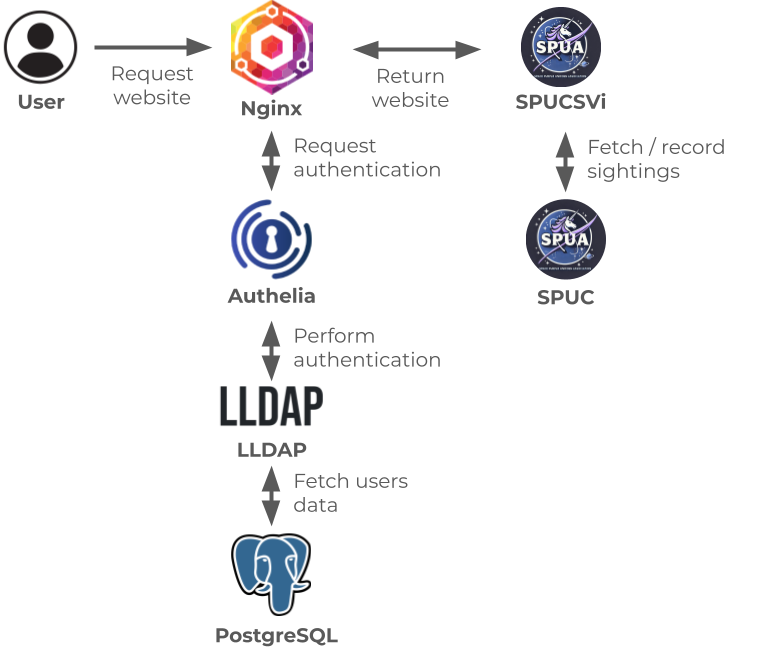And they lived happily ever after
Last updated on 2026-01-06 | Edit this page
Estimated time: 10 minutes
Overview
Questions
- How do I get the most out of Docker Compose?
- What is a microservices architecture?
Objectives
- Learn how combinations of microservices can achieve complex tasks with no or low code.
- Dissect a real world example of a microservices architecture.
So far, in our exploration of Docker Compose, we have focused on making our run commands more robust and on the orchestration of a stack. Much of the power of Docker, however, is not just the ability to package your own tools, but to use off the shelf tools to create powerful solutions.
Microservices
To be able to use Docker in this way, we need to use Docker Compose to create a microservices architecture.
The philosophy of microservices is to break down applications into small, manageable services. This is in contrast to the traditional monolithic approach, where all parts of an application are contained in a single codebase.
For example, an application might have a database, a web server, front and back ends, an API, a file store, a message queue etc. A monolithic approach would be to package all of these in the same codebase. This is conceptually simple, but can rapidly become unwieldy and difficult to maintain.
Using a tool like Docker Compose we can take a different approach. We can divide the application into smaller services, each of which is responsible for a single task. By breaking down the application into smaller services, we can take advantage of the best tools available for each part of the application.
In a microservices architecture, each tool runs as its own service, and communicates with other services over a network. The database, web server, front and back ends, and all the other services can be genuinely separate. This can enhance the security in the application, as each service can be isolated from the others.
Furthermore, since each of the tools can be best in their class, and maintained by an enthusiastic and expert community, there can be gains in performance. Docker Desktop helps in orchestrating these services, making it easy to start, stop, and manage them, which ends up being at least as simple as in a monolithic application (if not more).
For individual developers, it means less time writing code which has already been written, and more time focusing on the unique, and fun, parts of your application.
Microservices in Docker Compose
Docker Compose is the perfect tool for managing a microservices architecture.
To demonstrate the power of Docker Compose and microservices, let’s take a look at a more applied example.
The Apperture project is a stack of microservices. They combine to provide a log-in secure web portal with built in user-management. It is maintained by the University of Manchester’s Research IT team, and can easily be combined with other stacks to provide them with a login portal.
Apperture is comprised primarily of a compose file. Just
like we have been looking at!
The full compose.yml file is available on
github. It is quite long, so we will reproduce a slimmed down
version here.
YML
services:
proxy:
image: 'jc21/nginx-proxy-manager:latest'
ports:
- '80:80'
- '443:443'
depends_on:
- authelia
healthcheck:
test: ["CMD", "/bin/check-health"]
whoami:
image: docker.io/traefik/whoami
authelia:
image: authelia/authelia
depends_on:
lldap:
condition: service_healthy
volumes:
- ${PWD}/config/authelia/config:/config
environment:
AUTHELIA_DEFAULT_REDIRECTION_URL: https://whoami.${URL}
AUTHELIA_STORAGE_POSTGRES_HOST: authelia-postgres
AUTHELIA_AUTHENTICATION_BACKEND_LDAP_URL: ldap://apperture-ldap:3890
lldap:
image: nitnelave/lldap:stable
depends_on:
lldap-postgres:
condition: service_healthy
environment:
LLDAP_LDAP_BASE_DN: dc=example,dc=com
LLDAP_DATABASE_URL: postgres://user:pass@lldap-postgres/dbname
volumes:
- lldap-data:/data
lldap-postgres:
image: postgres
volumes:
- lldap-postgres-data:/var/lib/postgresql/data
healthcheck:
test: ["CMD-SHELL", "pg_isready -U lldap"]
volumes:
lldap-data:
lldap-postgres-data:This compose.yml file is a little more complex than the
ones we have been looking at so far, but it is still just a list of
services and their configurations.
You’ll see some familiar things, like image,
ports, depends_on (and
healthchecks), volumes, and
environment.
Notice the image field in the services
section of the compose.yml file. Every service is using a
pre-built Docker image from Docker Hub, straight off the shelf! This is
the power of Docker Compose and microservices!
To get an idea of what is going on, let’s draw a diagram of the
services in the compose.yml file.

In short: Without writing a single line of code, we have a fully functioning, secure web portal!
Combining Stacks
One of the most powerful features of Docker Compose is the ability to combine stacks. There is no reason we cannot combine the Apperture stack with the SPUC stack we have been working with in previous lessons!
This would allow us to protect our SPUC interface with the Apperture portal. An important addition! We need to ensure poachers cannot falsely record sightings of the rare yet valuable unicorns!
This can be achieved by making a couple of changes to the SPUC
compose.yml file.
In our previous lesson, we learned about networks, which allow services to communicate with each other. Now we want join the networks of the SPUC and Apperture stacks so that they can communicate with each other.
Couple this change with appropriate configuration of the proxy service, and you have a secure SPUC portal!

By combining the SPUC and Apperture stacks, we have created a powerful, secure web portal with no added code! But why stop there?
Rapid extension
There are some improvements we can make very quickly!
We can:
- Add a proper database to SPUC using
Postgres - Add support for unicorn-detecting sensors using
RabbitMQandTelegraf - Allow users to upload images of unicorns using
MinIO

This is the true strength of Docker Compose and microservices. By combining off the shelf tools, we can create powerful solutions with no or low code, and in a fraction of the time it would take to write everything from scratch.
They Lived Happily Ever After
We hope you now feel prepared to start your mission detecting unicorns, and that you use Docker for the good of our intergalactic community.
In behalf of the SPUA, we thank you for your commitment and support for the cause!

